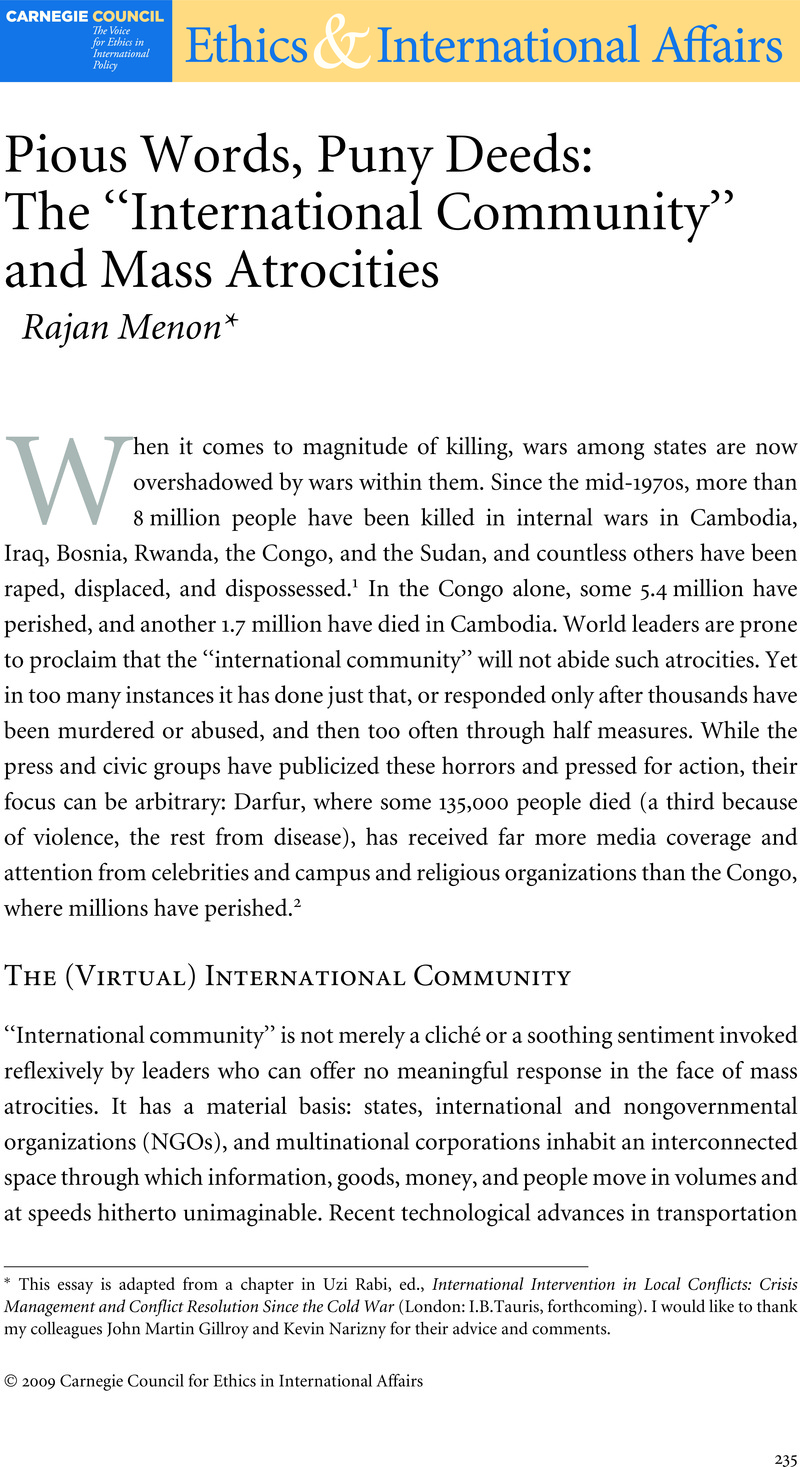Published online by Cambridge University Press: 25 March 2011

1 Cambodian Genocide Program; available at http:\\www.yale.edu/cgp/; International Rescue Committee, “Mortality in the Democratic Republic of Congo: An Ongoing Crisis,” 2007, available at http:\\www.theirc.org/resources/2007/2006-7_congomortalitysurvey.pdf; and BBC News, “UN Admits Rwanda Genocide Failure,” April 15, 2000; available at news.bbc.co.uk/2/hi/africa/714025.stm (all accessed May 27, 2009).
2 Mahmood Mamdani accepts this figure after assessing contending tallies. SeeMamdani, Mahmood, Saviors and Survivors: Darfur, Politics, and the War on Terror (New York: Pantheon, 2009), pp. 25–39.Google Scholar
3 Niebuhr, Reinhold, Moral Man and Immoral Society: A Study in Ethics and Politics (New York: Charles Scribner's Sons, 1932), pp. 49, 85See alsoNiebuhr, Reinhold, The Children of Light and the Children of Darkness (New York: Charles Scribner's Sons, 1944), ch. 5.Google Scholar
4 Grewe, Wilhelm G., Epochs of International Law, trans. and rev. byByers, Michael (Berlin: Walter de Gruyter, 2000), pp. 23–24.See alsoKoskenniemi, Martti, From Apology to Utopia: The Structure of International Legal Argument (Cambridge: Cambridge University Press, 2005).CrossRefGoogle Scholar
5 Annan, Kofi, “Problems without Passports,” Foreign Policy (September/October2002), pp. 30–31.Google Scholar
6 See Anderson, Benedict, Imagined Communities: Reflections on the Origin and Spread of Nationalism, rev. ed. (London: Verso, 2006);Google Scholar and Hobsbawm, Eric andRanger, Terence, eds., The Invention of Tradition (Cambridge: Cambridge University Press, 1992).Google Scholar
7 Mamdani, , Saviors and Survivors, chs. 1 and 2, and pp. 279–81.Google Scholar
8 Kirkpatrick, Jeanne J., “The Shackles of Consensus,” and Chomsky, Noam, “The Crimes of ‘Intcom,’” Foreign Policy (September/October2002), pp. 37, 34–35.Google Scholar
9 Ogata, Sadako, “Guilty Parties,” Foreign Policy (September/October2002), p.40.Google Scholar
10 Hume conceptualizes obligation as a function of proximity and intimate connection. SeeHume, David, A Treatise on Human Nature, Faye Norton, David andNorton, Mary J., eds. (New York: Oxford University Press, 2000), pp. 207, 309–10.Google Scholar
11 Nussbaum, Martha C., “Patriotism and Cosmopolitanism,” inCohen, Joshua, ed., For Love of Country? (Boston: Beacon Press, 2002), p.14.Google Scholar
12 Nussbaum, Martha C., Frontiers of Justice: Disability, Nationality, Species Membership (Cambridge, Mass.: Belknap Press, 2006), chs. 4 and 5.Google Scholar
13 Ibid., pp. 287, 291–95.Google Scholar
14 Ibid., pp. 306–07.Google Scholar
15 International Commission on Intervention and State Sovereignty, The Responsibility to Protect (Ottawa: International Development Research Centre, 2001)Google Scholar; see also Evans, Gareth, The Responsibility to Protect: Ending Mass Atrocity Crimes Once and For All (Washington, D.C.: Brookings Institution Press, 2008.Google Scholar
16 See the statement on R2P by China's UN ambassador (November 3, 2008);available at http:\\www.china-un.org/eng/ldhy/63rd_unga/t520980.htm; and “Russian Ambassador Challenges R2P Principle” (July 18, 2008); available at http:\\www.ir2p.org/2008/07/18/russian-ambassador-challenges-r2p-principle/(both accessed May 27, 2009).Google Scholar
17 Chandler, David, “The Responsibility to Protect: Imposing the ‘Liberal Peace,’” International Peacekeeping 11, no. 1 (2004), pp. 70–71, 76Google Scholar; and Ciar´n J. Burke, “Replacing the Responsibility to Protect: The Equitable Theory of Humanitarian Intervention,” Amsterdam Law Forum 1, no. 2 (2009), pp. 63–65.